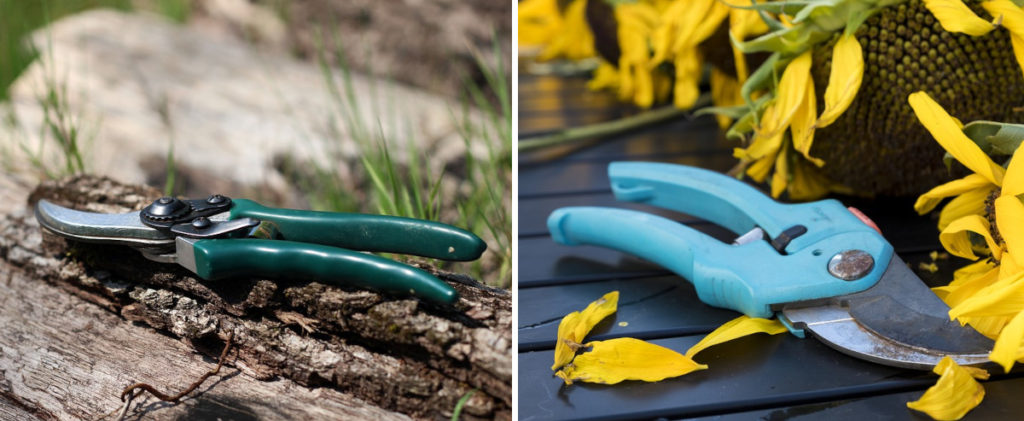Last Updated on March 19, 2023 by Editors
The Pruning Shears are the most common and useful gardening hand tools. In this guide you will discover the different pruner types and learn about the proper care of shears for pruning. If you have to buy a gardening hand tool to start your garden tool shed collection, then the hand pruner is probably the first you need to buy.
They are an essential tool for any gardener or landscaper. You can use them to trim and shape plants and they can make a big difference in the overall appearance of your garden. There are many different types of pruning shears available, so it is important to choose the right pair for the job.
Table of Contents
What are Pruning Shears
The hand pruners are small gardening hand tools. They are plant cutting tools that look and operate like scissors. Mainly, they are used for gardening tasks such as cutting and pruning parts of flowers, bushes, trees and other plants. There are pruning shears for each hand size and each budget.

Pruning Shears uses
The primary use of the hand pruners is to cut plants. Every part of the plant should be removed if it’s weak, damaged, diseased or dead – especially before new growth begins to encourage blooming. These tools are cutting shears for bushes and are able to prune small trees and shrubs. They can cut through branches up to about half an inch wide. In addition, they can be used for pruning houseplants to improve their appearance.
Types of Pruner Shears
There are three different types of shears for pruning plants: The anvil pruning shears, the bypass pruning shears and the ratchet pruners. You can use them to cut woody branches or green stems, depending on the type of the hand pruner.
1. Anvil pruners
These garden shears have only one sharpened blade. When you use them to cut, the upper sharpened blade meets a flat metal surface, the anvil; unlike bypass pruning shears. This gardening tool tends to crush the stems rather than slice them. The anvil pruning shears work well when you prune hard woody branches or thin dead woods. Typically, they are ambidextrous pruning shears.

2. Bypass pruners
The bypass hand pruner is the most basic pruning shears tool. It works like a pair of scissors, with its blades passing by each other to make a cut. It’s used for cutting stems and thin green branches. The bypass pruning shears are designed to delicately cut the soft twigs and are used for clean cuts. Of course, you can use them to cut deadwood and wooden branches but their design is not so great for this pruning task. Unlike anvil pruners, there are some special bypass left handed pruning shears.

3. Ratchet pruners
The ratchet hand pruner is a special type of pruning shears that features a helpful mechanism, the ratchet mechanism. In our experience this frustration free type of pruning shears is the best for removing larger dead, thick or hard branches. Also, the ratchet pruning shears are great for people that can’t put enough pressure to their hand pruners to prune with one cut. The ratcheting mechanism allows a single cut in more than one stages.
Pruning shears for roses
When you cut roses and prune rose bushes you want to make clean cuts. The right tool to prune roses is the bypass pruner. The same applies for pruning orchids, hydrangeas and other similar plants. For this task the shears’ blades should be sharp, not dull. Make sure to read about sharpening pruning shears below.
Where can you use Pruning Shears?
You can use these hand shears in your garden, your balcony, your patio area or in your house for your indoor plants! Generally, anywhere where a plant can grow. The hand pruners are the necessary tool you have to use when you want to produce clean and precise cuts.
Why should you get Pruning Shears for your garden?
Every plant needs cutting. The proper pruning improves the plant’s health, improves its vigor and encourages new flower or green growth. When you have to remove dead, damaged or diseased stems or branches you want to make precise cuts. Unlike most of the other gardening hand tools, the pruner is one the best tools to accomplish this task.
How to choose the right Pruner
Unfortunately, whether the product’s bad design, it’s awful material quality or the wrong usage, most of the pruning shears tend to break. Make sure not to cheap out when buying one and always have a couple of them at your garden shed or garden tool organizer as backups. Below are some considerations that you may have to make in order to choose the right pruner for you:
Handles
Usually, many hand pruners feature shock absorbing pads and shock-absorbing spring at the end of them and the start of the blades. Also, many of them have handles with specialized anti-slip material or design. The handle’s material whether it be steel, forged aluminium or plastic, doesn’t make a big difference because of the size of these hand pruners. What matters most is if they are comfortable to hold them in your hand and work with them while pruning.
Blades
Most of the times, the blade material is stainless steel, or a harder and tougher steel like carbon steel or high-carbon steel like the Japanese SK5 steel. Typically, the carbon or high-carbon steel blades are not resistant to corrosion and rust. For this reason, they have an anti-rust layer or coating. Many of them have a non-stick coating as well.
Length and Weight
Normally, the overall length of pruning shears is from 8 and up to 11 inches. Also, the hand pruner’s weight is not a real concern, unless you plan to use the pruning shears it every day as a professional. For that use there are some really heavy-duty pruning shears. Generally, it is a lightweight garden hand tool.
Other considerations
The best way to find the right tool is to evaluate the tool yourself. Visit a local hardware store and find out yourself if the pruners handles are comfortable and are a good fit for your hand. Feel if it has a comfortable cutting action. Additionally, check if its size and weight are perfect for your hand. Traditionally, well known brands like Felco or ARS make good garden tools and offer lifetime guarantee. Such pruning shears can be easily found at stores like amazon.com. Another way is to trust expert’s opinions or, at least, user opinions (for example your neighbors or close friends). If you are keen to read reviews then prefer the hands-on reviews only.
Pruning shears vs Hedge shears
Hedge shears are used for quick cutting. You make one big swing to cut many soft branches at once. On the other hand, if you want to do precise cuts or cut thick wooden stems, the hand pruners will do the job. In addition, the real question is: Shearing or pruning?
Shearing or pruning?
With shearing with a hedge shears tool or you trim it fast with a hedge trimmer you quickly give shape to your plants. You don’t care so much about the health of the plan but mostly the aesthetics of it. Generally, when you cut a part of a plant you encourage its growth. By cutting only the outer parts of it to give it a shape fast you encourage only the growth of the plant’s outside parts.
Photosynthesis
The outer edges grow quicker than the inner parts of the plant and hide the latter. Because of that the inner parts don’t get enough sun exposure. They don’t get enough light to convert it into chemical energy (photosynthesis). This light deficiency is one of the main reasons why these parts of the plant become unhealthy over time. On the flip side, when you prune a plant you selectively cut to remove certain parts of it. Usually, these parts are the diseased, damaged or dead parts. When you do that you improve the plant’s health. You can’t be so easily selective when you cut a plant with the help of the hedge shears tool.
Pruner maintenance
To keep your shears working properly and safely you should do some regular maintenance. In addition, they have one or two blades that need be sharp enough to make clean cuts to plants. For this reason, they require some special and careful attention every now and then. You have to do this maintenance if you want to keep your pruners for a long time.
Cleaning pruning shears
Remove the debris and clean your hand pruner with warm water after each use especially if it is particularly dirty. Plant remains are stubborn and get stuck on the blades if you forgot to remove them after putting away the hand pruners. In this case use a brush to remove them from the blades instead.
Use thick damp cloth or a towel to dry them really well. Pay attention to the blades and other metal parts to make sure that you removed any moisture from them.
Sterilizing pruning shears
Plant diseases are nasty and spread very easily. To prevent them from spreading from one plant to another you should disinfect them. Soak this gardening hand tool in a disinfectant to sterilize it when you are working on diseased plants. You don’t have to spend much to do so: The disinfectant can be one-part household chlorine bleach in nine parts water, isopropyl alcohol, or a household disinfectant diluted one to four.
Sharpening pruning shears
A sharp tool will cut really well. On the contrary, a dull blade might damage your plants. For these two reasons you should sharpen their cutting blades when they get quite dull. Firstly, make sure to remove rust from pruning shears with a sandpaper. Then you can use a medium whet sharpening stone or a diamond hand file to bring the sharpness back to your pruner. After sharpening the hand pruner, use a cloth to remove the metal debris and lubricate the cutting blades.
Storing
Thankfully, these are small garden hand tools. You should store them somewhere for easy access because you will use them very often. For this reason, you should put them in a box or a bag in your garden tool shed or your outdoor storage cabinet. Also, you can hang them. In any case, the storage place should be dry and not exposed to moisture. Additionally, remember to oil the blades with a lubricant and the moving parts of the hand pruning shears before winter. This will protect it from corrosion. For safety reasons, remember to lock the blades and keep these hand tools away from children.
As an Amazon Associate I earn from qualifying purchases. We may get commissions for purchases made through links in this post.

